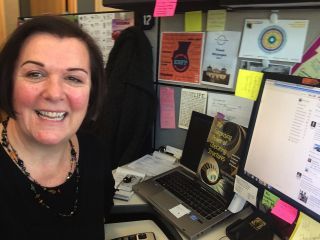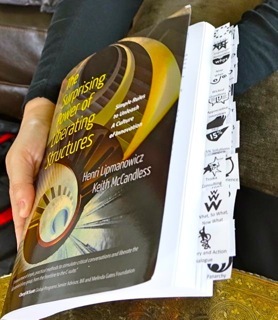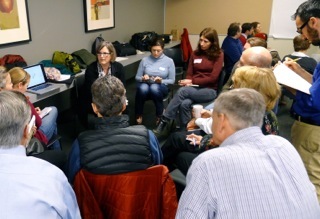![]() LS Book Club Starter Kit
LS Book Club Starter Kit
Learning to use Liberating Structures is like learning a new language. Practicing with others over multiple sessions accelerates your fluency very quickly. A LS book club is a great way to build your confidence putting LS into practice and to meet new people.
Here is a wonderful book club story from Julie O’Leary. Julie currently works at T-Mobile as a Senior Leadership Development consultant after a long career with Nordstrom. Graduate of Pepperdine University, MSOD (Master of Science in Organization Development) and has just completed a coaching certification from Hudson Institute of Coaching, Santa Barbara.
Julie currently works at T-Mobile as a Senior Leadership Development consultant after a long career with Nordstrom. Graduate of Pepperdine University, MSOD (Master of Science in Organization Development) and has just completed a coaching certification from Hudson Institute of Coaching, Santa Barbara.
I am a proud graduate of the Pepperdine MSOD program. One of the many benefits of this program is our active and generous alumni community. There are a handful of alumni and faculty who are using LS, including a group that will offer a break out session at our 40th anniversary conference in May.
One of the alum reached out on our Yammer pages to see if there was interest in starting a book club—our first book was “The Surprising Power of Liberating Structures! “ We had 10 people on the call (and 10 more weighed in via our Yammer pages). We had several of us who have been using LS to varying degrees, and several new or soon-to-be-new users.
Here is how the book club session unfolded:
1. Check In: We started with a brief check-in, who was in the virtual room, name, which class were you a graduate of, and one or two sentences about why you were here or whatever was on your mind.
2. Purpose + Experience Levels: After our check-in the facilitator started by asking about people's experience with LS: never heard of it; has heard of it, but never used it; beginning user; more experienced user; to what extent have you read the book. Prior to the call, she put out a couple of Yammer notices that it was okay to join in the call even if you hadn't read the book. The purpose was to generate dialogue, share knowledge, keep connected to MSOD people, and learn something new.
never heard of it; has heard of it, but never used it; beginning user; more experienced user; to what extent have you read the book. Prior to the call, she put out a couple of Yammer notices that it was okay to join in the call even if you hadn't read the book. The purpose was to generate dialogue, share knowledge, keep connected to MSOD people, and learn something new.
3. Diving Into the Content: The facilitator then suggested a framework, let's talk about the book, what struck you, what questions you have, and then lets hear from folks who've used it. She asked the users to talk about specific structures they've used, and we discussed how to combine individual structures into all-day or multi-day events. It was definitely an invitation and people agreed this sounded like a great way to get the conversation going. The facilitator also said that she would manage the time and would gently interrupt if we were running out of time (without being too forceful about it). All with a robust discussion and A&Q throughout.
4. Recording the Proceedings: Someone volunteered to take and posted them on the Yammer pages for people that could not attend.
5. Several people who missed the call, later commented on Yammer saying they will read the book and check out the website based on the published notes and written comments from the participants. More reason to publish notes if possible!
Here are some steps to help you get started with a book club:
- Get together a core group - It is much easier to start a LS book club with two or three people who already have some connection. Recruit people with shared interest in a specific domain or in liberating change methods. We recommend co-hosting with two hosts involved in each meeting.

- Set a regular meeting time - An ideal size for a face-to-face book club is 7-12 people. Virtual group can be much larger (e.g., up to 50). It is often difficult to coordinate schedules so go ahead and set a regular meeting time and date with your core group. For instance, one book club meets the second Tuesday of the month at 2 p.m. By setting the time before advertising the book club, you may avoid scheduling snafus.
- Promote your LS book club - The best advertising is often word of mouth. If you have a core group of three, and you each know two people who want to join, then all you have to do to start a book club is ask these people. This is a good way to meet friends of friends. If your core group doesn't know of other people to ask, then advertise in your circles and communities of practice. Social media really works.
- Establish a lively pattern of participation – We recommend using Liberating Structures to establish a pattern of participation for each meeting. 1-2-4-All is a great place to start whether you are meeting face-to-face or virtually. What, So What, Now What? is also a winner. Featuring different LS microstructures for each gathering—and for “homework” in between meetings—is highly recommended. Try a Tasting Menu approach.
- Meet - Set a schedule for the first months and start meeting. If the book club is small at first, don't worry about it. Invite people as you go. Liberating Structures are quite simple so anyone can catch up quickly.
- Feature a Mix of Ideas and Field Stories – Liberating Structures come alive through practice. Be sure to invite stories about applications from members with concepts and ideas from the book. We recommend inviting members to try out one or more methods between meetings. Their direct experience with including and engaging everyone will be a compelling topic for conversation. Try this progression of questions to draw out members with direct field experience: What happened? So What? Now What?
- Never stop inviting people - From time to time you'll have the chance to invite new people as other members move away or drop out. Don't be discouraged if you lose members or participation is uneven. People's schedules and commitments change.

The Surprising Power of Liberating Structures book!
Buy on Amazon The color paperback ($49.95 USD), black&white ($19.95 USD) and e-book are now available on the Amazon website. Amazon offers deep discounts and free shipping to some customers.
